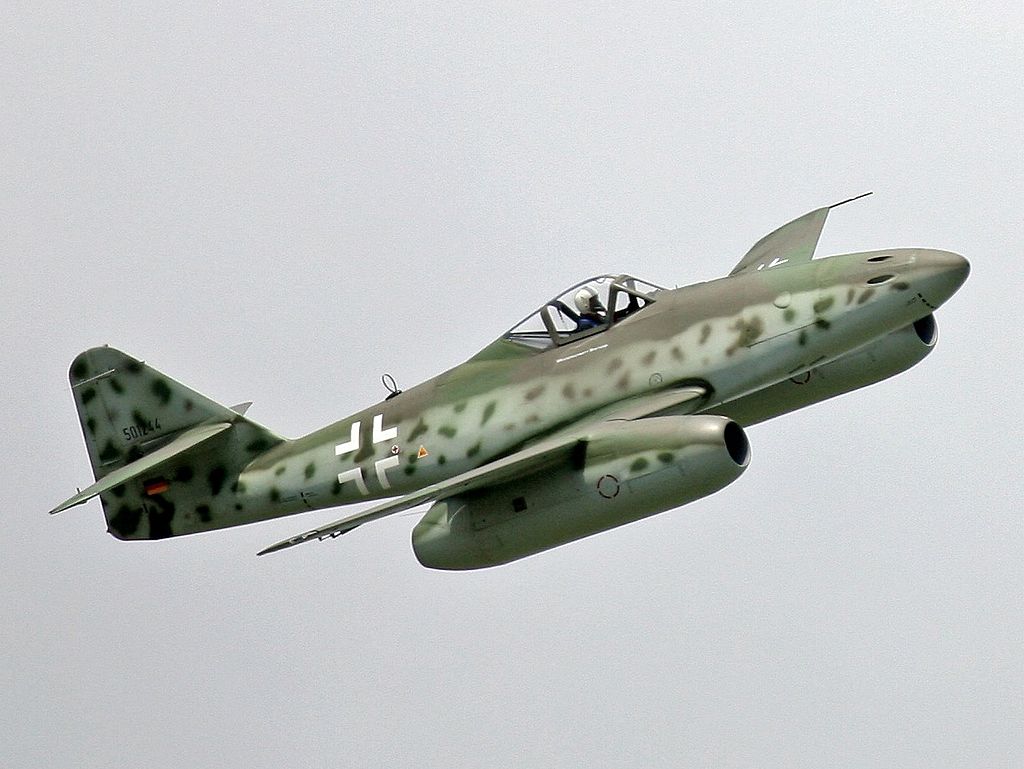Towards the end of World War II, an increasingly desperate Nazi hierarchy devised weapons that would help turn the tide of the war. These were known as the ‘Wunderwaffe’. From huge tanks and aircraft carriers to guided missiles, on paper the Third Reich was back in business. However, in reality, due to a lack of raw materials and manpower in a fast deteriorating Germany, this was not the case. One of the few successful prototypes was the Messerschmitt Me 262 – the world’s first jet fighter. It is difficult to imagine the sense of wonder that must have been felt by the Allied soldiers when first witnessing the 262. Many had heard rumours of Hitler’s wonder machines, but here was one in action. With its Junkers Jumo 004B-1 turbojets, it put any Allied fighter to shame and made the propeller-powered planes seem like relics from a bygone era.

Early days
The Third Reich had a habit of overproducing vehicles and aircraft. The Tiger II tank for example was, technologically speaking, one of the best tanks of the war, but was bogged down with manufacturing issues from the beginning. The Me 262 faced the same difficulties, and as a result, never realised its potential. The blame has often been attributed to Hitler for his insistence on delaying the project in favour of a fighter-bomber. However, recent study has unearthed information that puts the blame with the Nazi Ministry of Aviation rather than the Führer. It seems that the aviation hierarchy failed to see the potential of jet engines in aircraft so put it at the bottom of the pile after every ideas meeting. The development was known as Projekt P.1065 and was thought up as early as April 1939, but never got off the ground until it was too late. If this had not been the case, it’s quite a scary thought of what the jet Messerschmitt would have been able to achieve. Would jets have won the Battle of Britain? Would D-day have been achievable? Would the atomic bomb have been dropped on Berlin instead of Hiroshima?
In combat
Production finally lurched into gear in the spring of 1944 as the Greater Germanic Reich was already shrinking at a rapid rate. The first to take flight was in the ‘Erprobungskommando’ unit and was flown by Luftwaffe fighter ace Major Walter Nowotny. More than 1,400 were constructed but only 300 ever saw combat. Faster than any Allied fighter, the Me 262 was known as the ‘Schwalbe’ (swallow) and would undertake the role as a defensive interceptor. Alongside it was the fighter-bomber Me 262 A-2a ‘Sturmvogel’ (stormbird), which was developed at Hitler’s strict insistence.

The start of the new jet age got off to a stumble as the first 262 was shot down by a group of P-47 Thunderbolts in August 1944. However by 1945, the Messerschmitts were back in larger and more formidable formations. The Jagdverband 44 was one of these new squadrons who led successful attacks on the Allied bombers that had been ravaging German cities in a hail of firestorms. The jets were so quick that a bomber’s guns could simply not move their crosshairs quickly enough to down it. The Allies developed tactics of their own to take down the Third Reich’s new weapon. P-51 Mustangs were more manoeuvrable than the Me 262s, so they developed a tactic to attack the jets as they turned, as this was when they were most vulnerable. When escorting bombers, the Mustangs flew higher than before so they could dive bomb the enemy before the bombers were taken out. If this didn’t work, the Me 262 would be taken out when it was about to land, as it was much more vulnerable at low speeds.

The Allies knew they couldn’t often match the might of the jet engines in the air so they cut its production lines. The 262 could only take off from concrete runways, so it could only go airborne from a small amount of locations. A similar tactic to the bombing of the V-2 production centres, it demonstrated how integral the D-Day landings had been. If Britain had no troops on the ground, it would have been almost defenceless against an onslaught of rockets and jet fighters. The Third Reich’s dwindling resources were another issue as well, so even if the Luftwaffe bases weren’t attacked as forcefully, would they have had the supplies to have launched consistent assaults? Overall, the Me 262 claimed 509 Allied kills against approximately 100 losses. A tiny statistic among the death and destruction of World War II.

Decline and discovery
As the airfields of Nazi Germany were searched after the war, the technology of this jet engine Messerschmitt was viewed with the utmost curiosity. The legacy of the aircraft can be seen today with jets now standard in modern fighters and the idea of swept wings and twin pod engines in military and civilian planes alike. Almost the exact chassis was used in the post-war Czechoslovak Avia S-92 and CS-92, demonstrating the brilliance of the design. Looking back at Hitler’s Wunderwaffe, many can be viewed with a pinch of salt. The Messerschmitt Me 262 is one of the very few that bucks the trend, and if it was introduced earlier, things could have been very different in the war-torn skies of Europe.
Statistics
• Length: 10.6m (34ft 9in)
• Wingspan: 12.7m (41ft)
• Height: 3.5m (11ft 6in)
• Crew: 1
• Power Plant: 2 x Junkers Jumo 004B-1 turbojets
• Range: 1,049km (652 miles)
• Max Speed: 870km/h (541mph)
• Ceiling: 11,449m (37,565ft)
• Guns: 4 x 30 mm MK 108 cannons
• Bombs/Rockets: 2 x 550lb bombs/24 x 2.2in R4M rockets
Reference:
http://science.howstuffworks.com/messerschmitt-me-262.htm
http://militaryhistory.about.com/od/worldwariiaircraft/p/me262.htm
http://www.2worldwar2.com/me-262.htm
http://www.historylearningsite.co.uk/world-war-two/weapons-of-world-war-two/messerschmitt-262/
For more on the wackiest game changing inventions of the past, check out History of War magazine

